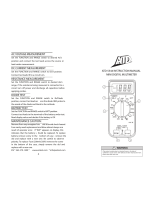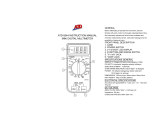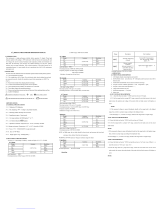Page is loading ...

Operating Instructions
Model MM44
Digital Multimeter
SAFETY INFORMATION
The following safety information must be observed
to ensure maximum personal safety during the
operation of this meter:
Do not use the meter if the meter or test leads look
damaged, or if you suspect that the meter is not
operating properly.
Never ground yourself when taking electrical
measurements. Do not touch exposed metal pipes,
outlets, fixtures, etc, which might be at ground
potential. Keep your body isolated from ground by
using dry clothing, rubber shoes, rubber mats, or
any insulating material.
Turn off power to the circuit under test before
cutting, unsoldering, or breaking the circuit. Small
amounts of current could be dangerous.
Use caution when working above 30V AC rms or
60V DC. Such voltages pose a shock hazard.
When using the probes, keep your fingers behind
the finger guards on the probes.
MM44 REV3 7/05
NOTE
This instrument is only to be used by a suitably
trained and competent person.
The symbols used on this instrument are:
Measuring voltage which exceeds the limits of the
multimeter may damage the meter and expose the
operator to a shock hazard. Always recognise the
meter voltage limits as stated on the front of the
meter.
HIGH ENERGY SYSTEMS
GS38 advises fused test leads to be used when
working on high energy systems. Suitable leads are
Martindale TL55.
SPECIFICATIONS
Display: 3½ digit liquid crystal display (LCD) with a
maximum reading of 1999.
Polarity: Automatic, positive implied, negative
polarity indication.
Overrange: (OL) or (-OL) is displayed.
Zero: automatic.
Low Battery Indication: The is displayed when
the battery voltage drops below the operating level.
Measurement rate: 2.5 times per second, nominal.
Operating environment: 0°C to 50°C at < 70% R.H.
Storage temperature: -20°C to 60°C, 0 to 80% R.H.
with battery removed from meter.
Accuracy: Stated accuracy at 23°C ± 5°C, < 75% R.H.
Battery life: 200 hours typical with carbon-zinc.
Battery: Single standard 9-volt battery, NEDA 1604,
JIS 006P, IEC 6F22, PP3.
Dimensions: 147mm (H)x 70mm (W)x 39mm (D).
Weight: Approx. 345g including holster.
Accessories: One pair test lead, One spare fuse, 9V
battery (installed) and Operating Instructions.
D C VOLTS
Ranges: 200mV, 2V, 20V, 200V, 600V
Resolution: 100µV
Accuracy: ± (0.8% rdg + 1 dgt)
Input impedance: 10M
Ω
Overload protection: 600VDC or AC rms
AC VOLTS: (50Hz - 500Hz)
Ranges: 200mV, 2V, 20V, 200V, 600V
Resolution: 100µ V
Accuracy: ± (1.5% rdg + 3 dgts) on 200mV to 20V
ranges
± (2.0% rdg + 3 dgts) on 200V to 600V ranges
Input impedance: 10M
Ω
Overload protection: 600V DC or AC rms
DC CURRENT
Ranges: 20mA, 200mA, 10A
Accuracy: ± (1.0% rdg + 1 dgt) on 20mA to 200mA
ranges
± (3.5% rdg + 4 dgts) on 10A range
Input protection: 0.5A/250V fast blow ceramic fuse
10A/600V fast blow ceramic fuse
AC CURRENT: (50Hz - 500Hz)
Ranges: 20mA, 200mA, 10A
Accuracy: ± (2.0% rdg + 4 dgts) on 20mA to 200mA
ranges
± (3.5% rdg + 4 dgts) on 10A range
Input protection: 0.5A/250V fast blow ceramic fuse
10A/600V fast blow ceramic fuse
RESISTANCE
Ranges: 200
Ω, 2kΩ, 20kΩ, 200kΩ, 2000kΩ, 20MΩ,
2000MΩ
Accuracy: ± (1.0% rdg + 4 dgts) on 200Ω ranges to
2000kΩ
± (2.0% rdg + 4 dgts) on 20MΩ range
± [(5.0% rdg - 10 dgts) + 10 dgts] on 2000MΩ range
Open Circuit volts: 0.3V DC
Overload Protection: 500V DC or AC rms
CONTINUITY
Audible indication: Less than 100
Ω
Overload protection: 500V DC or AC rms
DIODE TEST
Test current: 0.8mA ± 0.3mA
Accuracy: ± (3.0% rdg + 1 dgt)
Open circuit volts: 3.0V DC typical
Overload protection: 500V DC or AC rms
CAPACITANCE
Ranges: 2nF, 20nF, 200nF, 2µF, 20µF
Accuracy: ± (4.0% rdg + 10 dgts) on all ranges
Test frequency: 400Hz
TRANSISTOR hFE
Ranges: 0 - 1000
Base current: 10µA dc approx. (Vce = 3.0V DC)
Caution, risk of electric shock
Caution, refer to accompanying
documents
Equipment protected throughout
by Double Insulation (Class II)
Alternating current
Direct current
Ground
z
~
The instrument meets the requirements for double
insulation to BS EN 61010-1 at 600V Installation
Category III . Installation Category III (distribution
level) relates to transient overvoltage likely to be
found in fixed installation wiring.

FREQUENCY (Autoranging)
Ranges: 2kHz, 20kHz, 200kHz, 2MHz, 15MHz
Accuracy: ± (0.5% rdg + 2 dgts) on all ranges
Sensitivity: 1V RMS min.
Duty: <40% and > 60%
Overload protection: 500V DC or AC rms
LOGIC TEST
Threshold: Logic Hi (2.8 ± 0.8V)
Logic Lo (0.8 ± 0.5V)
Overload protection: 500V DC or AC rms
INPUT WARNING BEEPER
Incorrect test lead placement will cause this meter to
issue a warning beeper sound. The warning beeper
indicates that a test lead is plugged into a current
input socket and the Function/Range switch is not
set to a current range. For instance, if the red test
lead is plugged into the mA current socket and the
meter switch is set to 200V, the warning beeper will
sound. Another safety feature to protect the meter
and you.
OPERATION
Before taking any measurements, read the Safety
Information Section. Always examine the instrument
for damage, contamination (excessive dirt, grease,
etc.) and defects. If any abnormal conditions exist
do not attempt to make any measurements.
MM44 REV3 7/05
Voltage Measurements
1. Connect the red test lead to the "VΩ" socket and
the black test lead to the "COM" socket.
2. Set the Function/Range switch to the desired
voltage range and slide the "AC/DC" selector switch to
the desired voltage type. If magnitude of voltage is
not known, set switch to the highest range and
reduce until a satisfactory reading is obtained.
3. Connect the test leads to the device or circuit being
measured.
4. For DC, a (-) is displayed for negative polarity;
positive polarity is implied.
Current Measurements
1. Set the Function/Range switch to the desired
current range and slide the "AC/DC" selector switch to
the desired current type.
2. For current measurements less than 200mA,
connect the red test lead to the mA socket and the
black test lead to the COM socket.
3. For current measurements of 200mA or greater,
connect the red test lead to the 10A socket and the
black test lead to the COM socket.
4. Remove power from the circuit under test and open
the normal circuit path where the measurement is to be
taken. Connect the meter IN SERIES with the circuit.
Resistance and Continuity
1. Set in the Function/Range switch to the desired
resistance range or continuity position.
2. Remove power from the equipment under test.
3. Connect the red test lead to the "VΩ" socket and
the black test lead to the "COM" socket.
4. Touch the probes to the test points. In ohms, the
value indicated in the display is the measured value
of resistance. In continuity test, the beeper sounds
continuously, if the resistance is less than 100
Ω.
Note when using 2000M
Ω Range
The 2000MΩ range has a fixed 10-count offset in
the reading. When the test leads are shorted
together in this range, the meter will display 010.
This residual reading must be subtracted from the
reading. For example, when measuring 1100M
Ω on
the 2000MΩ range, the display will read 1110, from
which the 10 residual is subtracted to obtain the
actual resistance of 1100M
Ω.
Diode Tests
1. Connect the red test lead to the "VΩ" socket and
the black test lead to the "COM" socket.
2. Set the Function/Range switch to the " "
position.
3. Turn off power to the circuit under test.
4. Touch probes to the diode. A forward-voltage
drop is about 0.6V (typical for a silicon diode).
5. Reverse probes. If the diode is good, "OL" is
displayed. If the diode is shorted, "000" or another
number is displayed.
6. If the diode is open, "OL" is displayed in both
directions.
7. If the junction is measured in a circuit and a low
reading is obtained with both lead connections, the
junction may be shunted by a resistance of a less
than 1kΩ. In this case the diode must be
disconnected from the circuit for the accurate testing.
Transistor Gain Measurements
1. Set the Function/Range switch to the desired hFE
range (PNP or NPN type transistor).
2. Never apply an external voltage to the hFE sockets.
Damage to the meter may result.
3. Plug the transistor directly into the hFE sockets.
The sockets are labelled E, B and C for emitter, base
and collector.
4. Read the transistor hFE directly from the display.
Capacitance Measurements
1. Set the Function/Range switch to the desired Cx
(capacitance) range.
2. Never apply an external voltage to the Cx sockets.
Damage may result.
3. Insert the capacitor leads directly into the Cx sockets.
4. Read the capacitance directly from the display.
Logic Measurements
1. Set the Function/Range switch to the LOGIC
position.
2. Connect the red test lead to the "V
Ω" socket and
the black test lead to the "COM" socket.
3. Connect the red test lead to the test point and the
black lead to the common buss of the logic circuit.
4. A " " on the display indicates TTL logic high and
a " " indicates a TTL logic low. Both indicators are on
when the point of measurement is toggling high and low.
Frequency Measurements
1. Set the Function/Range switch to the kHz position.
2. Connect the red test lead to the "V
Ω" socket and
the black test lead to the "COM" socket.
3. Connect the test leads to the point of measurement
and read the frequency from the display.
MAINTENANCE
Battery Replacement
Power is supplied by a 9 volt "transistor" battery.
(NEDA 1604, IEC 6F22, PP3). The appears on
the LCD display when replacement is needed. To
replace the battery, remove the three screws from the
back of the meter and lift off the front case. Remove
the battery from case bottom.
Fuse Replacement
If no current measurements are possible, check for a
blown overload protection fuse. There are two fuses; F1
for the mA socket and F2 for the 10A socket. For access
to fuses, remove the three screws from the back of the
meter and lift off the front case. Replace F1 only with
the original type 0.5A/250V, ceramic, fast acting
fuse. Replace F2 only with the original type
10A/600V ceramic, fast acting fuse. The use of other
fuses may cause damage to the meter, invalidate the
warranty and impair the safety of the user. Domestic
‘Plug Top’ fuses should not be used.
Instrument Repairs and Spare Parts
Apart from the battery and fuses, there are no user
serviceable parts inside. If you suspect that the meter
is not operating properly, please check fuses, battery
and leads.
If the meter is still suspected of being faulty please
contact:
Martindale Electric Co Ltd,
Metrohm House, Imperial Park, Imperial
Way, Watford, Hertfordshire, WD24 4PP, UK
Tel: 01923 441717 Fax: 01923 446900
Accessories
F1 - 20x5mm 500mA 250V Ceramic -
Ref: FUSE500250 (Pack of 3)
F2 - 1x1/4” 10A 600V Ceramic - Ref: FUSE10600
(Pack of 3)
Fused test leads to GS38 specification - Ref: TL55
Soft foam lined carry case - Ref: TC55
WARNING
Remove test leads before changing battery or fuse
/



